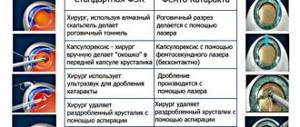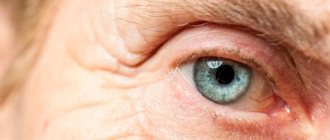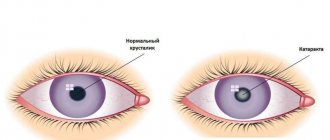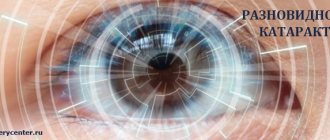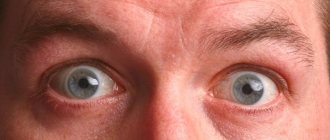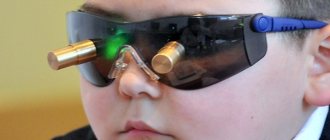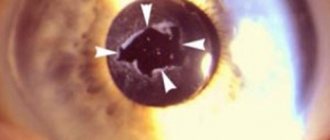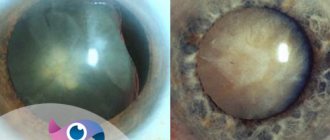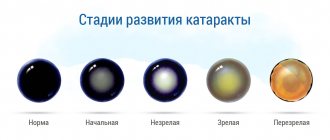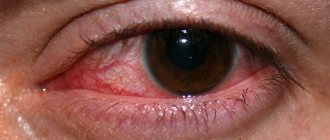Long before the advent of eye microsurgery, healers tried to understand the mechanisms of cataract development and find healing agents that could, if not cure, then at least slow down its development. Literally on the surface lay the assumption that some kind of influence was required on the diseased lens of the eye, which seemed so close and accessible for various kinds of instillation, washing, warming, etc. However, at the present stage it is considered proven that a radical cure is only possible through surgery. However, many patients are in no hurry to resort to it, knowing that lens replacement is possible at any time. The road to a microsurgical clinic often runs through lengthy and, no matter how much one would like to believe the opposite, fruitless attempts at conservative treatment, or even self-medication.
The decision that it is time for surgery is made by the patient together with the doctor. If the functional condition of the eye deteriorates slowly and the quality of life does not suffer too noticeably, you can try to slow down the rate of clouding of the lens with topical medications, for example, eye drops.
Which drugs are better
Eye drops are products that can help only at the initial stage of the disease. Very often during this period, doctors prescribe the amino acid taurine (drugs “Taufon”, “Taurine”, etc.). Taurine stimulates recovery processes in various eye pathologies, so it is used for traumatic, senile, diabetic and radiation cataracts. Since clouding of the lens is irreversible, eye drops for cataracts do not cure or restore the transparency of the lens, they only help slow down the progression of the disease.
It is worth saying that there are a great variety of drugs for the treatment of cataracts. They differ in their effectiveness, composition and cost. The most popular are: “Taufon”, “Oftan Katahrom”, “Vitafacol”, “Quinax”, “Vicein”, etc. These are the drugs that are usually prescribed by an ophthalmologist after an appropriate examination.
When prescribing cataract therapy with eye drops, ophthalmologists give particular preference to Quinax. This drug was developed by international ophthalmology and is considered very effective in the treatment of this disease. The active ingredients of the product are able to protect the lens protein from progressive clouding. However, achieving a positive result is only possible with long-term use of the drug.
Prevention
There are general recommendations to maintain good vision and prevent surgical intervention:
- regular examination by an ophthalmologist at least once a year;
- moderate physical activity, walks in the fresh air;
- limiting UV radiation, the influence of computers, TV and other gadgets;
- balanced diet;
- timely treatment of diseases of the organs of vision.
Patients with diabetes are advised to monitor their blood sugar levels and follow a diet.
If glaucoma has already been diagnosed, it is important to prevent its further development and prevent surgery. Regularly instill drops that reduce intraocular pressure (only those recommended by your doctor), limit heavy lifting, regulate fluid intake, and do not overexert yourself. It is also worth giving up bad habits.
Video about eye drops for cataracts
Cataract drops are usually used several times daily. The drugs are prescribed in the initial stages of the disease, when the vitamins they contain, biogenic stimulants and inorganic salts (Katachrome, Secatalin) are especially needed. In parallel, it is recommended to use products containing riboflavin, glutamic and ascorbic acids.
Many drugs contain nicotinic acid, which ensures the supply of ascorbic acid to the structures of the eye. Replacement therapy for cataracts is the introduction into the eye of those components, the deficiency of which is especially significant in the development of cataracts.
Various vitamins are also widely used in the drug treatment of cataracts. As a rule, they are used together with a glucose solution (2-5%), which has a beneficial effect on eye nutrition. Calcium, magnesium, potassium, cysteine, and glutathione preparations have also proven themselves well. Cysteine is used to treat any cataracts; it is instilled in courses. This element is often included in many complex drops (for example, Smirnov drops, Vita-Yodurol, Viceina).
Prevalence, causes and risk factors
According to modern data, about 20 million blind people live on the planet due to cataracts, and, above all, in countries with a low level of medical development. During the year, for every million people, about 3,000 operations are needed to eliminate the consequences of cataracts, according to WHO.
In the Russian Federation, more than 1% of the population consults an ophthalmologist about cataracts, and, most often, people who have reached 60 years of age and older. If we visit any eye department that performs surgeries, 40% of the patients in that department will be diagnosed with cataracts and admitted for surgical treatment.
If we consider the data of the medical and social examination (MSE), which registers people as visually disabled, then patients with cataracts are in third place after glaucoma, injuries of the visual organs, and make up about 19%.
However, if cataracts are diagnosed in a timely manner and treated correctly, then in almost 98% of cases complete restoration of vision is possible. What are cataracts and why does it occur?
Nature of the disease
There are a large number of factors that can trigger the development of cataracts. Main reasons:
- eye injury;
- infectious diseases with complications;
- high degree of myopia;
- diabetes;
- dermatological diseases;
- long-term use of corticosteroids;
- avitaminosis;
- bad ecology;
- exposure to electromagnetic waves and ionizing radiation;
- drug or infectious intoxication;
- thyroid diseases.
Congenital cataracts are observed in cases where a pregnant woman has suffered from rubella, toxoplasmosis, infectious disease and influenza. Cataracts can occur against the background of Fuchs syndrome, glaucoma and retinal detachment.
Risk factors include dark eye color, female gender, smoking, black skin and alcoholism.
Using walnuts, blueberries, calendula
If a cataract is detected, treatment with folk remedies without surgery has positive reviews when the disease has not acquired a mature form. There is a recipe for eye drops based on walnuts. Its kernels are finely crushed and filled with vegetable oil. The proportion is: approximately 1 part nuts to 10 parts butter. The mixture should infuse for about a week (the container should be shaken periodically). It is used as follows: two drops of this mixture are dropped into the eyes 3 times a day.
Another good remedy is calendula infusion. 15 grams of flowers are poured with boiling water (500 ml) and infused for three hours. Then take 150 ml of this liquid (per day). You can also wash your eyes with this infusion.
Blueberries are a berry that is extremely beneficial for the eyes. During the season it must be consumed regularly. At other times, you can eat dried berries. There is also a recipe for eye drops: blueberry juice is diluted with boiled water (it should be twice as much). Use once a day for several months.
Surgical intervention
If the disease cannot be stopped, then the only way to help restore vision is surgery. During this procedure, the clouded lens is removed, and an implant (silicone, plastic) is installed in its place. Phacoemulsification is also performed. Its peculiarity is that such intervention can be carried out in the early stages of the disease. The duration of the procedure is short, it is performed on an outpatient basis and the patient is discharged immediately. Vision is restored during the intervention. In some cases, a laser is used (secondary cataract, formation of a film behind the artificial lens). After eye surgery, it is forbidden to lift weights, avoid hot water, and visits to the sauna. Experts also recommend wearing sunglasses.
Types of drops that reduce intraocular pressure
Drops for the treatment of glaucoma are produced in large quantities. Each of them contains certain drugs, which can be divided into several groups:
- Based on the active component, beta blockers, prostaglandins, cholinomimetics, etc. are distinguished.
- According to the mechanism for eliminating intraocular hypertension, there are drugs that reduce the synthesis of aqueous humor, drugs that improve its outflow, and combined drugs.
Prostaglandin analogues
Prostaglandins are the safest and most effective agents for the treatment of glaucoma. 2 hours after instillation of this group of medications, the pressure inside the eye begins to decrease, and the maximum effect is observed after 12 hours.
This group of drugs includes Travatan, Tafluprost, Xalatan. All of them appeared relatively recently, but due to their high efficiency and duration of action (up to 24 hours), these drugs have become very popular in the treatment of patients with glaucoma.
Prostaglandins help restore the outflow of aqueous humor through additional pathways. However, these drugs also have some side effects. These include:
- Temporary redness of the eyes as a result of an increase in the diameter of the superficial arteries;
- Changes in the color of the iris due to pigment accumulation;
- Stimulates the growth of eyelash hairs; they also darken and become thicker (this effect is sometimes beneficial and can be used for cosmetic purposes).
Beta blockers
The mechanism of action of beta blockers is to reduce the synthesis of aqueous humor. They begin to act half an hour after instillation, and the effect reaches its maximum after about 2 hours. The frequency of use is higher than that of prostaglandins (usually 2 times a day), which is less convenient for the patient. Often, beta blockers for the treatment of glaucoma are combined with prostaglandins to increase the effectiveness of therapy.
There are a large number of eye drops belonging to this group (Timolol, Okumol, Arutimol, Okumed, Okupress, etc.). The active substance used in the drops is usually the same, so they are all interchangeable.
Beta blockers can have negative effects on body systems, such as causing bradycardia or bronchospasm. Therefore, this group of drugs is not used in patients with concomitant pulmonary emphysema, heart or vascular diseases, or bronchial asthma.
Highly selective beta blockers, which have significantly fewer side effects, include Betoptik.
Carbonic anhydrase inhibitors
Carbonic anhydrase inhibitors include Azopt and Trusopt. The mechanism of their action is associated with inhibition of intraocular moisture production. These medications are quite effective and, at the same time, safe, since there are practically no side effects when using them. The only thing is that patients with certain diseases of the excretory system need to be careful. Typically, carbonic anhydrase inhibitors are prescribed for double use; they are often combined with other groups of drugs (beta blockers, prostaglandins).
Diacarb tablets have a similar effect to Azopt, so it can also be prescribed to patients with glaucoma, especially during an acute attack of intraocular hypertension.
Cholinomimetics
The drugs Pilocarpine and Carbocholine are used to normalize the outflow of aqueous humor through the drainage system. They lead to narrowing of the pupillary opening and contraction of other muscle fibers, as a result of which the angle of the anterior chamber is freed from obstructions. Most often, cholinomimetics are prescribed to patients with angle-closure (narrow-angle) glaucoma to increase the size of the angle. The frequency of use is 1-2 times a day. These drugs are combined with drugs from other pharmacological groups (beta blockers, prostaglandins, carbonic anhydrase inhibitors).
Due to the pronounced narrowing of the pupillary opening, when using these medications, the field of vision may narrow and pain may appear in the temporal, frontal and superciliary areas.
Combination drugs
For the convenience of patients, several eye drops have been developed, consisting of active substances from different groups. This allows you to reduce the number of vials with medications, and sometimes the frequency of instillation.
Most often, ophthalmologists prescribe the following combination drops:
- Xalacom, which includes Timolol and Xalatan;
- Cosopt, consisting of Timolol Trusopt;
- Fotil, which contains Pilocarpine and Timolol.
Rehabilitation
After cataract and glaucoma surgery, the patient can go home within a few hours. In the presence of severe concomitant diseases in the postoperative period, it is necessary to remain under observation in the hospital in order to prevent possible complications.
After simultaneous treatment or surgery for glaucoma and cataracts, the patient receives a memo with the doctor’s recommendations for the next month after surgery, a list of medications and a regimen for taking them. The date of the next visit to the ophthalmologist is set.
Physical activity is limited, time spent at the computer or TV is established, and a clear daily routine is established.
In our clinic, after the operation, the patient is under the supervision of doctors. He is regularly examined by an ophthalmologist to avoid complications and the development of infectious diseases after the intervention. Thanks to the experience of our surgeons, this risk is minimal.
Cost of services
| Operation | rub. |
| Computer phacoemulsification with implantation of a flexible multifocal IOL Restor (USA) (prepayment for 1 eye 45,000) | 103 000 |
| Computer-assisted phacoemulsification with implantation of flexible multifocal IOL Lentis (USA) (prepayment for 1 eye 45,000) | 103 000 |
| Computer-assisted phacoemulsification with implantation of a multifocal toric IOL Lentis (USA) (prepayment for 1 eye 70,000) | 128 000 |
| Computer phacoemulsification with implantation of a flexible multifocal IOL Rayner M-flex (England) (prepayment for 1 eye 33,000) | 91 000 |
| Computer-assisted phacoemulsification with implantation of a flexible toric IOL Rayner (England) (prepayment for 1 eye 20,000) | 78 000 |
| Computer phacoemulsification with implantation of a flexible toric IOL Rayner (England) (in complicated cases, on a single eye) (prepayment for 1 eye 20,000) | 88 000 |
| Computer phacoemulsification with implantation of a flexible toric IOL Acrysoft IQ Natural (USA) (prepayment for 1 eye 23,000) | 81 000 |
| Computer-assisted phacoemulsification with implantation of a flexible toric IOL Acrysoft IQ Natural (in complicated cases, on a single eye) (USA) (prepayment for 1 eye 23,000) | 91 000 |
| Computer-assisted phacoemulsification with implantation of a flexible multifocal toric IOL Rayner (England) (prepayment for 1 eye 50,000) | 108 000 |
| Computer phacoemulsification with implantation of a flexible multifocal IOL Zeiss Atlisa (Germany) (prepayment for 1 eye 45,000) | 103 000 |
| Computer phacoemulsification with implantation of a flexible trifocal IOL Zeiss Atlisa (Germany) (prepayment for 1 eye 60,000) | 118 000 |
| Computer phacoemulsification with implantation of a flexible multifocal toric IOL Zeiss Atlisa Toric (Germany) (prepayment for 1 eye 60,000) | 118 000 |
| Computer phacoemulsification with implantation of a flexible toric IOL Zeiss At Torbi (Germany) (prepayment for 1 eye 35,000) | 93 000 |
| Computer phacoemulsification with implantation of a flexible toric IOL Zeiss At Torbi (Germany) (in complicated cases in a single eye) (prepayment for 1 eye 35,000) | 103 000 |
| Computer phacoemulsification with implantation of a flexible trifocal IOL Panoptix Alcon (prepayment for 1 eye 60,000) | 118 000 |
| Computer phacoemulsification with implantation of a flexible toric IOL Panoptix Alcon (prepayment for 1 eye 75,000) | 133 000 |
| Computer phacoemulsification with implantation of a flexible IOL (made in the USA or England) ( on promotion , without discount) | 38 000 |
| Computer-aided phacoemulsification with implantation of a flexible Bi-Flex IOL (discounts do not apply) | 45 000 |
| Computer phacoemulsification with implantation of flexible IOL Rayner (England) aspheric | 58 000 |
| Computer-assisted phacoemulsification with implantation of a flexible Rayner IOL (England) (in complicated cases, on a single eye) | 68 000 |
| Computer-assisted phacoemulsification with implantation of flexible IOL Acrysoft Natural (USA) | 62 000 |
| Computer-assisted phacoemulsification with implantation of a flexible IOL Acrysoft Natural (USA) (in complicated cases, on a single eye) | 72 000 |
| Computer-assisted phacoemulsification with implantation of flexible IOL Acrysoft IQ Natural (USA) | 73 000 |
| Computer phacoemulsification with implantation of flexible IOL Acrysoft IQ Natural (USA) (in complicated cases, on a single eye), Alcon 3-piece IOL | 83 000 |
| Computer-assisted phacoemulsification with implantation of a flexible Tecnis IOL (USA) | 75 000 |
| Computer-assisted phacoemulsification with implantation of a flexible Tecnis IOL (USA) (in complicated cases, on a single eye) | 85 000 |
| Computer-assisted phacoemulsification with implantation of a flexible Zeiss IOL (Germany) | 79 000 |
| Computer-assisted phacoemulsification with implantation of a flexible Zeiss IOL (Germany) (in complicated cases, on a single eye) | 89 000 |
